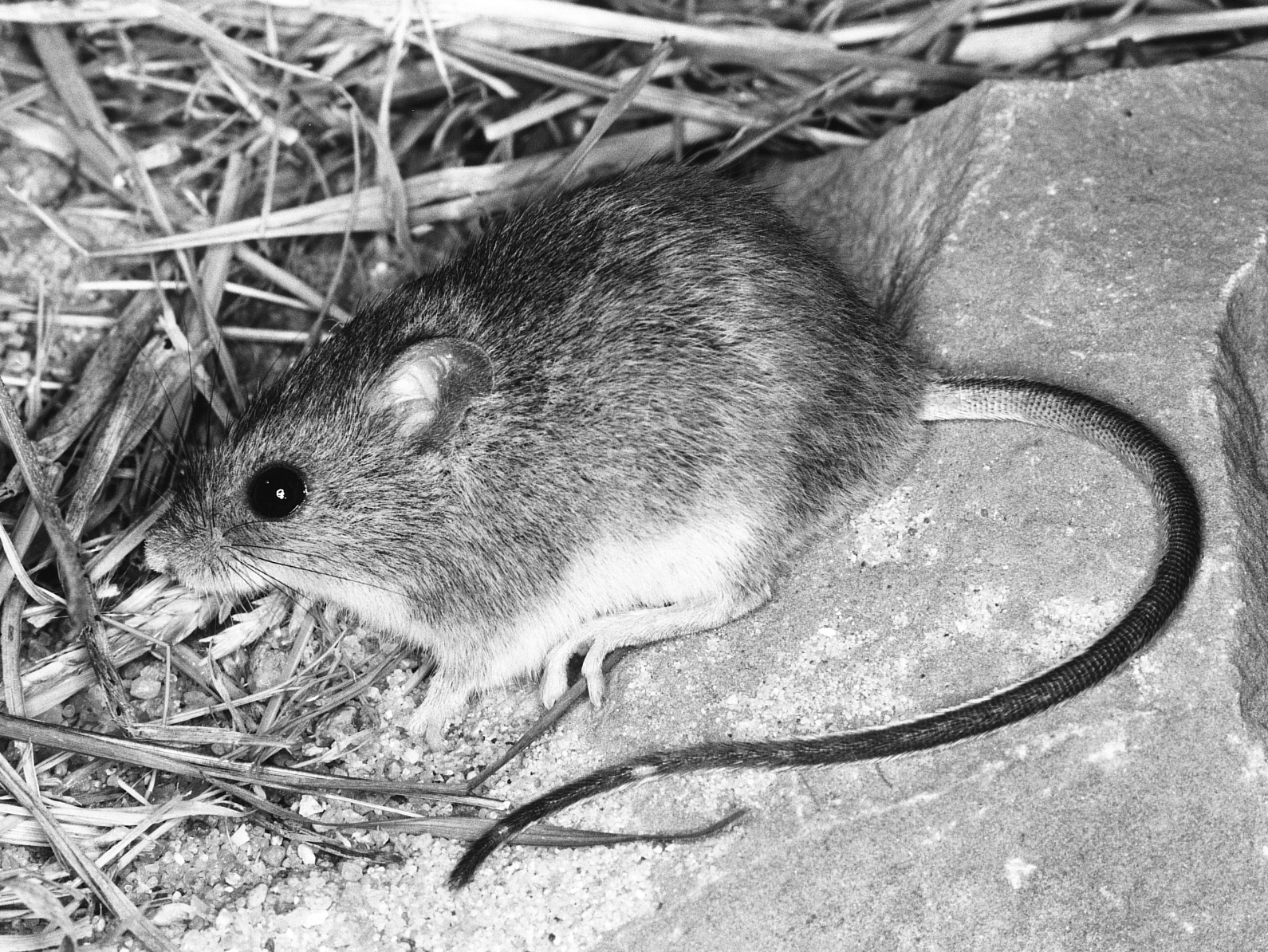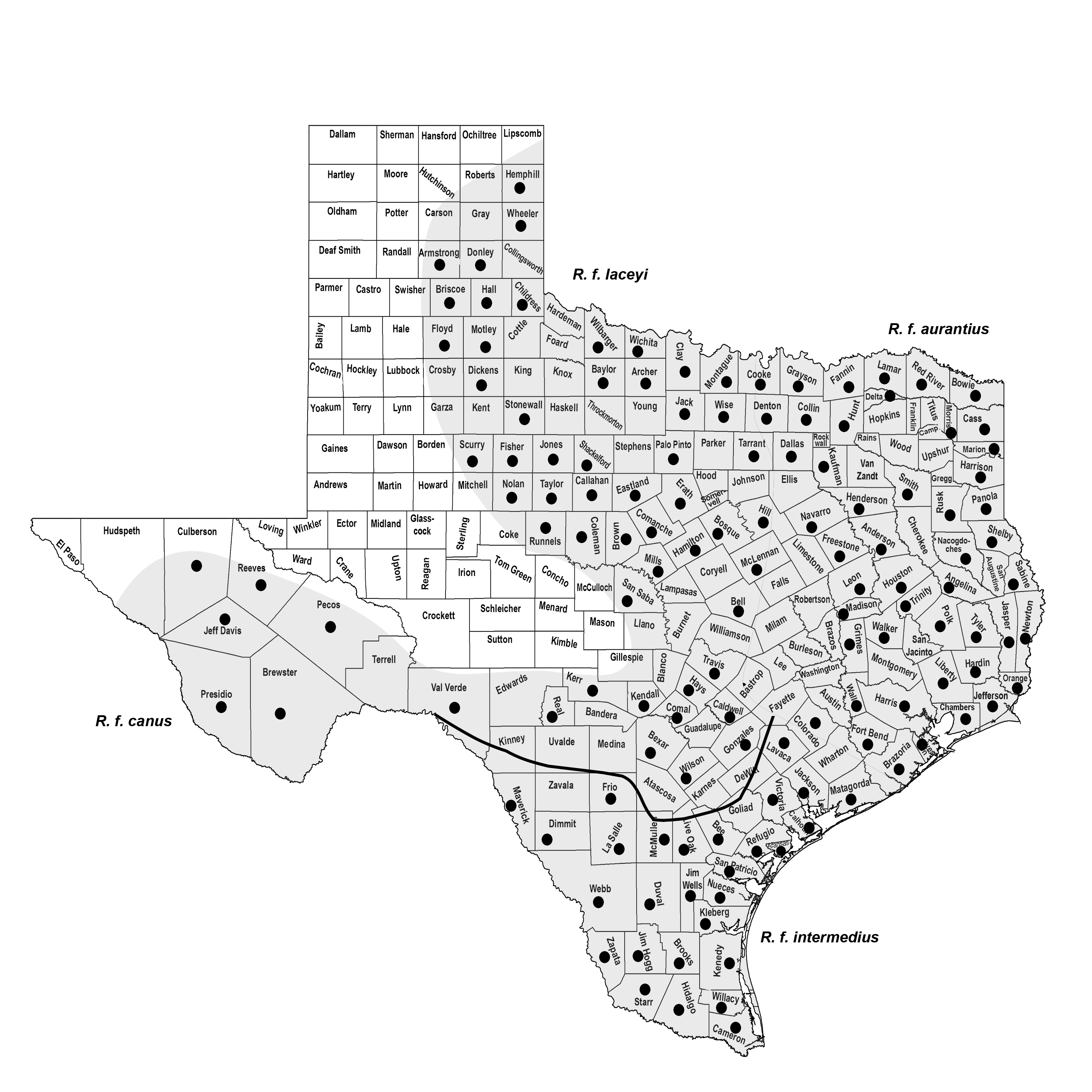FULVOUS HARVEST MOUSE
Reithrodontomys fulvescens J. A. Allen 1894
Order Rodentia : Family Cricetidae
DESCRIPTION. A small mouse with grooved upper incisors, tail much longer than head and body, and inside of ears covered with reddish hairs; differs from the pocket mice (Perognathus and Chaetodipus), which also have grooved upper incisors and long tail, in the absence of external cheek pouches. Upperparts ochraceous buff, sparingly mixed with blackish brown, sides nearly clear buff; underparts white or pale buff. Dental formula: I 1/1, C 0/0, Pm 0/0, M 3/3 × 2 = 16. Averages for external measurements: total length, 165 mm; tail, 93 mm; hind foot, 20 mm. Weight, 14–30 g, averaging about 18 g.

DISTRIBUTION. Occurs in eastern and central Texas (west to Hemphill, Armstrong, and Floyd counties in the north) and in parts of the Trans-Pecos region. Absent from western Panhandle and Llano Estacado.

SUBSPECIES. Reithrodontomys f. aurantius in the eastern part of the state, R. f. canus in the eastern and southern Trans-Pecos, R. f. intermedius on the Rio Grande Plains and in adjacent areas of southern Texas, and R. f. laceyi in the central part of the state.
HABITS. These largest of harvest mice occur chiefly in grassy or weedy areas dotted with shrubs or in creek bottoms with their tangles of grasses, vines, and bushes. In Big Bend Ranch State Park, in southern Presidio County, they showed an affinity for riparian woodlands, although they also occurred in desert scrub dominated by mesquite. In preferred habitat, they travel on their own small trails or use those of their animal associates, cotton rats, rice rats, and white-footed mice.
In addition to living in underground burrows, many of them have nests in bushes above the ground. These arboreal homes may be converted bird nests or completely of the fulvous harvest mouse's own architecture. One found in central Texas was a remodeled cardinal's nest about 1.3 m above the ground in a yaupon bush. When the nest was disturbed, the mouse quickly left it, descended to the ground by jumping from branch to branch, and entered an underground burrow. The mouse's nest, about the size of a baseball, neatly filled the cavity of the bird's nest. It was composed of shredded grass and weed stems and had one opening on the side. Another nest was about 7 cm above the ground in a clump of bluestem (Andropogon).
Their food is primarily vegetable matter, including seeds and the green blades of grasses and sedges, but may include invertebrates. In coastal areas of Texas, invertebrates predominate in the diet of these mice, but in regions with greater seasonal variation in climate, vegetation dominates the diet in fall and winter and invertebrates are more important in spring and summer. Their food habits are somewhat opportunistic and based on food availability. They are known to feed on the ground as well as up to 1 m high in vegetation. They are nocturnal and are active year-round.
In Texas, it appears that the breeding season extends from February to October, although peaks in reproductive activity occur in late spring and early autumn. Litter size may range from two to six, averaging three or four. The gestation period probably is about 21 days. At birth, the pups are naked, blind, and helpless and weigh about 1 g each. Weaning occurs at 13–16 days when the pups weigh 3–3.5 g. By day 11, the young are well furred, and at 9–12 days the eyes open.
These mice seldom conflict with humans. Their known predators are barn owls, barred owls, and red-tailed hawks, but doubtless other animals also feed on them.
POPULATION STATUS. Common. The fulvous harvest mouse is commonly encountered throughout its range. At times it can be abundant in weedy or grassy habitats intermixed with shrubs, vines, and bushes. It has fared well since the turn of the century as mesquite and other brush have covered many areas of the state that were formerly prairie or grassland.
CONSERVATION STATUS. The IUCN lists the fulvous harvest mouse as a species of least concern, and it does not appear on the federal or state lists of concerned species. This species is in no danger in Texas.
From The Mammals of Texas, Seventh Edition by David J. Schmidly and Robert D. Bradley, copyright © 1994, 2004, 2016. Courtesy of the University of Texas Press.
Natural Science Research Laboratory
-
Address
Museum of Texas Tech University, 3301 4th street, Lubbock, TX 79409 -
Phone
806.742.2486 -
Email
nsrl.museum@ttu.edu

